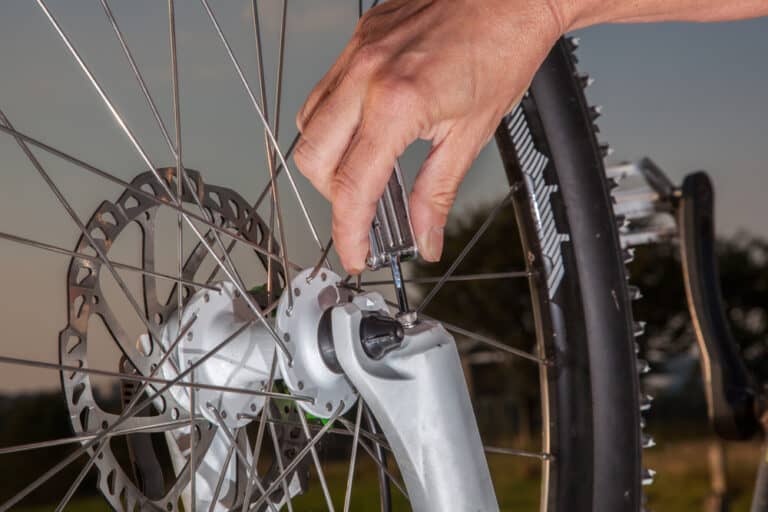How Many Headset Spacers MTB?

Comfort and correct posture is a must when riding your MTB. Adjusting the seat and handlebars to create the right riding height is crucial to increase your endurance. Depending on your size, how many headset spacers does your MTB need?
Mtb can have between 30mm and 100mm headset spacers. The number of spacers will depend on the size or length of the rider. There is no set rule to the number of spacers needed. Taller MTB riders need more headset spacers to get the correct handlebar height.
Mountain bikes typically have one standard headset spacer of 30mm, allowing for a basic headset setting. A 30 mm headset spacer is usually all needed to give the correct headset height, but sometimes more is required for an MTB. Let’s see how many headset spacers you may need.
How Many Headset Spacers MTB?
If you have a factory standard Mtb but are a tall cyclist, your Mtb headset may need a few spacers to adjust the height of your handlebars. You may need up to 110mm spacers to get a comfortable, ergonomic riding position.
Each mtb rider must measure to get the correct height requirements and acquire the correct spacers.
Typically you would only need one 30mm or two 15mm headset spacers on a mountain bike headset. Smaller or shorter cyclists can adjust the seat and handlebars using factory standard accessories.
Headset spacers are available in convenient sizes allowing you to group them, creating the perfect height for your handlebars.
Headset spacers are available in sizes ranging from 1mm to 30mm and are available in the following materials:
Headset spacers can be bought in packs of multiple-size spacers or singles. In addition, some headset spacers can be color-coded to match your Mtb color scheme.
Are Headset Spacers Necessary On MTB?
Headset spacers are necessary on an MTB, especially if you battle to adjust the handlebars and get a comfortable riding position. The benefit of having several different size headset spacers is that you can get it as close as possible to the desired height.
The only time headset spacers are optional is if your MTB’s head tube is designed for use with a zero-stack headset. A zero-stack headset has a removable cup that houses the bearing inside the head tube.
The zero-stack headset can be adjusted anywhere with ease. Typically a zero-stack headset is provided with a long stem. The stem is measured and cut at the desired length. In the frame, you have two cups housing the bearings.
On top of the two cups is a cap to seal the bearings in and then a clamp that fits onto the steering tube of the Mtb.
To hold it together, there is a bolt that you fasten with a star nut. Then, any adjustments you need to make to the headset can be easily made with a 4-or-5mm Allen or hex key.
The Allan key is a much smaller, lighter, and more convenient way to make adjustments than the massive wrenches of decades ago.
Headset spacers can be used with threadless and threaded steerer tubes or headsets.
Should There Be A Spacer Between Headset And Stem?
Having a spacer between the headset and stem is not a must, but many cyclists like having at least one spacer between them. What is rare is having a headset spacer below the stem.
Although some cyclists recommend having a 2mm or 5mm spacer below the stem, it is purely personal. Certain manufacturers mention not fitting spacers above the stem due to the top cap design. In that case, using a spacer below the stem makes sense.
If you need to use a spacer below the stem, it is best to use the smallest possible, that way, it will not interfere with the design, safety, and function of the Mtb.

Should Headset Spacers Be Able To Spin?
As somebody that can see a disaster looming, a headset spacer should not spin to avoid one. Why does that matter?
If the spacers can spin, there is too much space between the headset and stem, and you may need another spacer.
It is also an indication that the bearings do not have enough pre-load. The effect of that will be the headset will be too loose. Insert the looming disaster here if you get on your Mtb with a headset that is too loose.
So what can you do to ensure the headset spacers do not spin?
Fixing a spinning headset spacer:
Or alternatively:
The headset spacers should not be able to spin after the adjustments. A slight movement is fine, and disaster has been thwarted.
How To Fit Headset Spacers On Mtb?
You need two key tools and a few minutes to properly fit headset spacers on your mountain bike. It’s a straightforward process if you follow these steps:
- Using a 4-or5mm hex key ( Allan key), loosen the headset top cap
- Using the correct mm hex key, loosen the stem
- Remove the headset
- Remove any stock headset spacers
- Place the desired amount of spacers around the stem
- Replace the headset stem and see if the adjustment is correct before tightening everything
- Replace the top cap to set the pre-load on the bearings
- Tighten the top cap enough that there is no play on the headset
- If the top cap is too tight, you will have resistance when turning the front wheel
- Align the handlebars – they must be perpendicular to the front wheel of your Mtb
- Tighten the stem bolts
Conclusion
The correct headset height on Mtb impacts your ride and performance. Handlebars that are too short or high will change how you pedal and handle the Mtb, causing an accident or injury.
The benefit of different-size spacers is that it allows for adjustments that can be made in a few minutes.







